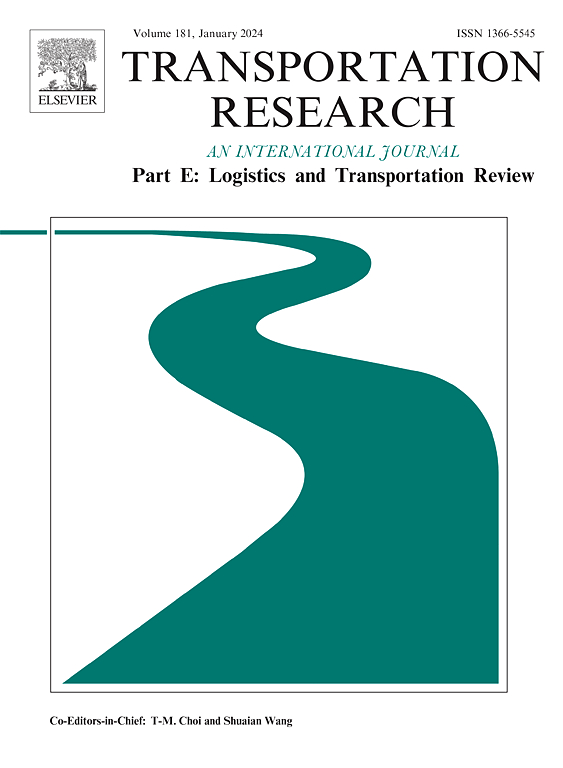供应链中的信息服务与质量策略
IF 8.3
1区 工程技术
Q1 ECONOMICS
Transportation Research Part E-Logistics and Transportation Review
Pub Date : 2025-05-08
DOI:10.1016/j.tre.2025.104169
引用次数: 0
摘要
电子商务平台通常提供信息服务。本研究探讨供应链环境下产品制造企业的资讯服务策略与原始设备制造商(OEM)的品质策略。OEM将生产外包给竞争对手的合同制造商(CM), OEM和CM都通过平台销售自己的产品,并支付预设的佣金。EP决定是否向两家制造商提供有关消费者质量偏好的信息,从而产生相关成本。OEM需要通过战略性地设定相对于CM的产品的最佳质量水平来确定其产品质量策略。通过建立博弈论模型,推导出EP的最优信息服务策略和OEM的最优质量策略。我们的研究结果表明,当CM的产品成本质量比较低或获取信息的成本较低时,平台更倾向于提供信息服务。此外,当成本质量比较高时,OEM选择的产品质量相对于CM的产品质量较低。结果表明,企业信息服务具有两种效应:增加产品质量投资(质量歧视效应)和价格调整驱动下的竞争加剧(竞争加剧效应)。当消费者具有低质量偏好时,这些效应显著影响OEM的质量策略,导致CM产品的成本质量比较低时,质量和销售价格降低。有趣的是,这些影响可能会相互冲突,导致OEM在这个比例相对较高时同时提高质量和销售价格。我们的研究提供了有价值的管理见解,表明当CM的产品成本质量比较低或获取消费者质量偏好成本较低时,EPs应该提供信息服务。oem厂商应该战略性地调整他们的产品质量相对于CM的产品,特别是当针对低质量偏好的消费者。扩展证实了从我们的主要模型得到的主要结果的稳健性。本文章由计算机程序翻译,如有差异,请以英文原文为准。
Information service and quality strategies in a supply chain
E-commerce platforms (EPs) commonly provide information services. This study explores an EP’s information service strategy and an original equipment manufacturer’s (OEM) quality strategy in a supply chain. The OEM outsources production to a competing contract manufacturer (CM), and both the OEM and the CM sell their products through the platform, paying a preset commission. The EP decides whether to provide information on consumer quality preferences to the two manufacturers, incurring an associated cost. The OEM needs to determine its product quality strategy by strategically setting the optimal quality level relative to the CM’s product. By developing a game-theoretical model, we derive the optimal information service strategy for the EP and the quality strategy for the OEM. Our findings show that the platform prefers to provide the information services when the CM’s product has a low cost-quality ratio or when obtaining the information is inexpensive. In addition, the OEM opts for lower product quality relative to the CM’s product when the cost-quality ratio is high. We identify two effects of the EP’s information service: increasing product quality investment (quality-discrimination effect) and intensifying competition (competition-intensification effect) driven by price adjustments. These effects significantly impact the OEM’s quality strategy when consumers have low-quality preferences, leading to reduced quality and selling price when the cost-quality ratio of the CM’s product is low. Interestingly, these effects may conflict, inducing the OEM to increase both quality and selling price when this ratio is relatively high. Our study provides valuable managerial insights, suggesting that EPs should provide the information service when the CM’s product has a low cost-quality ratio or when obtaining consumer quality preferences is inexpensive. OEMs should strategically adjust their product quality relative to the CM’s product, especially when targeting consumers with low quality preferences. Extensions confirms the robustness of the major results derived from our main model.
求助全文
通过发布文献求助,成功后即可免费获取论文全文。
去求助
来源期刊
CiteScore
16.20
自引率
16.00%
发文量
285
审稿时长
62 days
期刊介绍:
Transportation Research Part E: Logistics and Transportation Review is a reputable journal that publishes high-quality articles covering a wide range of topics in the field of logistics and transportation research. The journal welcomes submissions on various subjects, including transport economics, transport infrastructure and investment appraisal, evaluation of public policies related to transportation, empirical and analytical studies of logistics management practices and performance, logistics and operations models, and logistics and supply chain management.
Part E aims to provide informative and well-researched articles that contribute to the understanding and advancement of the field. The content of the journal is complementary to other prestigious journals in transportation research, such as Transportation Research Part A: Policy and Practice, Part B: Methodological, Part C: Emerging Technologies, Part D: Transport and Environment, and Part F: Traffic Psychology and Behaviour. Together, these journals form a comprehensive and cohesive reference for current research in transportation science.

 求助内容:
求助内容: 应助结果提醒方式:
应助结果提醒方式:


